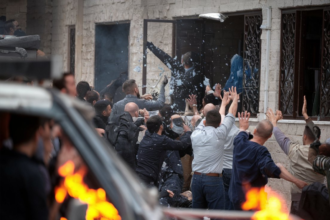With at least 18 people dead and 19 more injured as South Korea’s wildfires rage across the southeast, the nation is suffering one of the biggest wildfire tragedies in its history. The Ministry of the Interior and Safety claims that thousands of military soldiers and firefighters are fighting many blazes, resulting in significant evacuations and damaging priceless cultural legacy sites.
As the destruction mounts, the fires have spurred national and worldwide attention. As the fires spread quickly throughout several provinces, residents have been compelled to abandon farms, businesses, and homes. Authorities have set up emergency shelters to house displaced people; food, water, and medical aid are given to the evacuees.
What is the degree of the current wildfire crisis?
Han Duck-soo, the acting president of South Korea, has called the continuing fires “unprecedented,” saying they were “rewriting the record books for the worst South Korea wildfires in our nation’s history.” With more than 23,000 people evacuated and large swathes of forest devastated, the scenario has become critically severe.
With the flames consuming over 17,000 hectares of forest, this ranks third in the area affected by South Korea’s wildfires in history. With eighteen deaths recorded, the wildfire catastrophe the nation has ever seen is already the deadliest one.
Emergency alerts issued by local governments advise citizens to remain vigilant and ready for more evacuations should they be needed. Thick smoke covering multiple cities and lowering visibility on essential roads and highways has also resulted from the flames, causing extreme air pollution.
Which sites of cultural legacy have suffered?
Of all the losses, the 1,300-year-old Gounsa Temple in Uiseong, constructed in 618 AD, has been burnt. One of the most prominent temples in the province, this one was significant in South Korea’s Buddhist legacy. Furthermore, forestry authorities confirmed the destruction of a Buddhist architectural monument designated as a national heritage from the Joseon Dynasty (1392–1910) by the flames.
Experts in history and culture have shown their sadness at the loss of these unique sites. Though some sites may never be wholly restored, efforts will be made to evaluate the damage and investigate possibilities.
How is the government handling the catastrophe?
About 5,000 military soldiers and thousands of firefighters have been sent to tackle the flames. To help contain the fire, authorities have also hired US military helicopters stationed in Korea.
For the first time this year, the national fire agency issued the highest degree of crisis alert on Tuesday. Even with the broad response, strong gusts have seriously impeded firefighting activities.
“We were fervently hoping for rain today or tomorrow to help put out the flames,” Han Duck-soo remarked. The Korea Meteorological Administration, however, said that just a small amount—between five and ten millimeters—was expected on Thursday and that none was expected for Wednesday.
Apart from attempts at firefighting, the government has promised financial support to farms, companies, and other households suffering significant losses. Those whose homes have been destroyed are being housed temporarily.
What other difficulties have surfaced during efforts at firefighting?
Just after lunchtime on Wednesday, a firefighting helicopter tragically crashed in the foothills of Uiseong County. The reason for the crash is under investigation by authorities right now.
The blazes first broke out last Friday in Sancheong County, in the nation’s southeast. However, the South Korean flames have expanded quickly to adjacent towns, including Uiseong, Andong, Cheongsong, Yeongyang, and Yeongdeok.
Strong gusts that keep fanning the flames have been one of the main challenges in underlining fire control. The winds force the fire in several directions; hence, firefighters have found it difficult to create containment lines. Aerial firefighting attempts have also been challenging since helicopters cannot run safely in unstable circumstances.
Why is South Korea's wildfire frequency rising?
With less-than-average rainfall, South Korea has been experiencing drier-than-usual conditions. The nation has registered 244 wildfires so far this year, 2.4 times more than in the same period last year. The government admits that the leading causes of these fires are individual irresponsibility and unauthorized burning.
According to experts, the frequency and intensity of South Korean wildfires are also rising due to climate change. Increasing temperatures and extended dry spells create perfect conditions for wildfires to start and spread quickly.
“We would see smaller fires that could be quickly under control in past years,” remarked a forestry official. “Now, the fires are expanding faster than ever before, and their size makes containment quite challenging.”
Officials have pledged to raise public awareness of fire prevention and intensify enforcement against unauthorized burning. “Once a wildfire starts, extinguishing it requires tremendous resources and puts precious life in danger,” Han Duck-soo said, underlining the importance of long-term solutions.
What lessons will this tragedy teach?
Once the crisis was under control, the South Korean government promised to scrutinize any flaws in wildfire response.
“We will closely examine our firefighting plans and make required changes to stop such disasters in the future,” Han said.
Authorities are debating more rigid fire safety rules, including stricter penalties for unauthorized burning and more monitoring in high-risk regions. Additionally, investments in improved firefighting technologies, particularly sophisticated aerial firefighting tools, are under discussion.
Environmentalists warn that the nation must also proactively solve deforestation and climate change, which are aggravating fire conditions. Reducing the impact of upcoming South Korean wildfires could depend heavily on reforestation efforts and sustainable land management techniques.
Overcoming one of the biggest natural catastrophes in recent memory would prove difficult for South Korea, with the fires remaining ablaze and continuous containment efforts. While the country is already preparing for a protracted rehabilitation, the magnitude of the devastation will only become evident once the flames are completely quenched.








